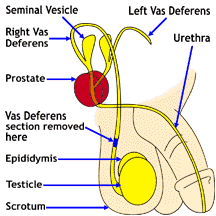SAN LUIS OBISPO COUNTY (PASO ROBLES), CALIFORNIA
Benefits of a No-Scalpel Vasectomy. No Incision, No Removable Stitches.
The No-Scalpel vasectomy was developed by a Chinese surgeon, Dr. Li, in 1974, and used extensively throughout China ever since. It was introduced to the U.S. in late ‘80’s after a group of American physicians went to China to study the procedure and were convinced of its benefits over conventional techniques. In 1988, this particular group conducted a study in Bangkok, Thailand where over 1200 vasectomies, both no-scalpel and conventional methods, were performed in one day. The group found that the no-scalpel technique was associated with eight fold fewer complications than the conventional method.
Vasectomies, as a means of permanent male sterilization, have been around for many years and afforded a safe and popular option for couples who no longer want children, or men who do not desire an unintentional pregnancy.
Traditionally, before the no-scalpel approach, the procedure required an incision(s) in the scrotum, stitches, and some degree of pain.
In contrast, the no-scalpel approach utilizes a small puncture in the middle of the scrotum, no removable stitches, and superior anesthesia technique. As a result, there is less pain during the procedure, and because there is less surgical manipulation, there is often much less pain after the procedure.
Although the no-scalpel procedure is safe, simple and quick, I am sure you agree that the decision is significant. We encourage patients to consider their needs carefully before electing sterilization. If you are interested in the no-scalpel vasectomy outside of San Luis Obispo County, you can request an up-to-date list of doctors in your area who do this procedure at this website:
http://www.noscalpelvasectomy.com
The No-Scalpel Technique
The no-scalpel technique utilizes a one single puncture which is made in the middle of the scrotum, and through this puncture the vas is grasped using a special instrument. Manipulation and ligation of the vas deferens is similar to the conventional method. The procedure is performed using a unique local anesthetic approach, and the use of oral Valium as a relaxant. The no-scalpel approach represents a significant improvement over conventional techniques in that it is more elegant, less traumatic and less painful.
Six Reasons for a man to have a vasectomy
- You want to enjoy sex without worrying about pregnancy
- You do not want to have more children than you can care for
- Your partner has health problems that might make pregnancy difficult
- You do not want to risk passing on a hereditary disease or disability
- No desire to use/or continue to use other means of birth control
- You want to save your partner from surgery/associated risks involved in having her “tubes tied”, and save the expense
Advantages of the “No-Scalpel” Approach
- No incisions
- Simple and gentle procedure
- No sutures which require removal
- Less traumatic to the tissues
- Less time to perform
- Quicker recovery
- Less pain during and after procedure
- 1/8 less complications, which include bleeding and infection
- Equal in efficacy, as compared to conventional approaches
- A single, small puncture entry—No incisions!
Q & A
Q. What is a vasectomy and how does it work?
A. The purpose of a vasectomy is to prevent the delivery of sperm from the testes, where they are produced, to the outside world, where in some situations may result in pregnancy. The vas deferens is small tube, approximately the caliber of a spaghetti strand, which carries sperm from the testicles to the opening of the penis. By interrupting this conduit (i.e. vasectomy procedure), sperm can no longer be incorporated with the semen and thus, unable to result in pregnancy.
Anatomy
Q. What is different about the No-Scalpel approach, versus conventional methods?

A. The No-Scalpel Vasectomy is different from a conventional approach in the way the vas deferens is accessed. Instead of making two vertical incisions on each side of the scrotum, which require suturing at the end of the procedure, the no-scalped approach involves making an approximate 3mm puncture with a specialized instrument in the middle of the scrotum, which is allowed to heal without sutures. Additionally, the no-scalpel procedure utilizes a superior anesthesia method involving a complete vasal nerve block, which makes the pain virtually absent during the procedure. Once the “tubes” are accessed, the two approaches are very similar— there may be small variations, from physician to physician, in how the vas deferens are treated once they are exposed.
Q. Will the vasectomy procedure change me sexually?
A. No. There is no evidence whatsoever that this procedure with alter your libido or ability to perform sexually. In fact, many men cite that sex is more relaxed and enjoyable than before without the anxiety of a potential pregnancy.
Q. What kind of physicians perform vasectomies?
A. Usually a Family Physician or a Urologist, although some Surgeons are trained to do it as well.
Q. Will I receive some sort of sedation prior to the procedure?
A. Yes, a relaxant called Diazepam (i.e. Valium) is offered which if used, is given approximately 1 hour prior to the procedure. If Valium is administered, it will be necessary that someone be designated to drive you home after the procedure.
Q. Will I be sterile immediately after the vasectomy?
A. No. After the vasectomy, active sperm will remain in your system. It requires 15-20 ejaculations to clear your system of the sperm. Thus, we advise some means of contraception until it is determined that there is no sperm in your ejaculate. We ask patient to return in approximately 6-8 weeks after 25-30 ejaculations, with a semen specimen that we analyze for sperm.
Q. Is the procedure permanent?
A. Yes and no. We counsel that the no-scalpel vasectomy is permanent, with a failure rate of less than 1/400. There is a vasectomy reversal procedure performed my Urologists which can reverse the vasectomy in about 60-70% of the cases if done within 3 years. The cost of the reversal procedure is between $7,000-$10,000. Because of these two reasons, we consider the no-scalpel vasectomy largely irreversible.
Q. How long does the procedure take?
A. In most cases, approximately 20 minutes.
Q. When can I return to work?
A. If the procedure is performed on a Friday, which is often the case, one can return to a desk job on Monday. We ask, however, that you not perform any heavy physical labor, or lifting greater that 20 lbs. for at least 10 days after the vasectomy.
Q. When can I resume sexual intercourse?
A. 1 week after the vasectomy and when you are comfortable, but remember to use another means of birth control until we determine your sterility. Because the no-scalpel approach is associated with very little post-operative pain, one must be aware of this false sense of security and not over exert themselves—this relates to all activity where the scrotum is moved vigorously (e.g. jogging, jumping etc.).
Q. Can my sperm be saved prior to a vasectomy?
A. Although rarely utilized, Pre-Vasectomy Sperm Banking is available. It is relatively simple/easy and inexpensive, especially compared to a vasectomy reversal.
Q. How much does the procedure cost?
A. The procedure costs $600, which includes a 1 week post-op visit and semen analysis. A consultation visit fee is separate and costs $150–it is required at least 3 days prior to the procedure. If both the consultation and procedure are paid for all at once, the price is discounted to $700 for both.
If your insurance covers this service, we will accept whatever they allow for the vasectomy and/or consultation visit(s) (this excludes applicable co-payments). If needed, our office would be happy to help you determine the details of your insurance coverage in this regard.
After the Procedure
Following the procedure it is important that you remain off your feet as much as possible for the first 24-48 hours, using an ice pack applied over your scrotal support as much as possible. This decreases swelling and risk of complications, including bleeding. After 72 hours, most men are able to return to a desk job. No lifting greater than 20 lbs. is recommended during the first 10 days after the procedure. You may resume sexual intercourse in 1 week if physically able. We advise against vigorous intercourse for the first 10 days. Semen analysis should be brought to the office 6-8 weeks after the procedure using the method described in the post-op instructions.


